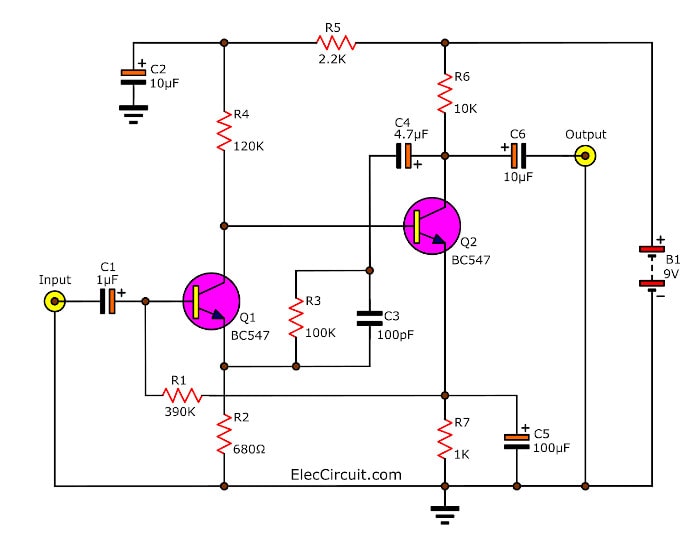Transistor Amplifier

Transistor amplifier
Transistor Amplifier A transistor acts as an amplifier by raising the strength of a weak signal. The DC bias voltage applied to the emitter base junction, makes it remain in forward biased condition. This forward bias is maintained regardless of the polarity of the signal.
What are the 3 types of amplifiers using a transistor?
Three of the most fundamental transistor amplifiers are: common emitter, common collector and common base.
When transistor is used as an amplifier?
One of the key characteristics of a transistor is that it can be used as an amplifier. Transistors can act as amplifiers while they are functioning in the active region or when it is correctly biased. The need for transistor as an amplifier arises when we want to increase or amplify the input signal.
Where are transistor amplifiers used?
Applications of Transistor as an Amplifier
- It can be used in long-distance communication because the intensity of the signal obtained at the output will be high.
- In the radio signals amplification, these transistor amplifiers are utilized.
- The amplifiers play a prominent role in wireless communication.
Why transistor is used for?
A transistor can act as a switch or gate for electronic signals, opening and closing an electronic gate many times per second. It ensures the circuit is on if the current is flowing and switched off if it isn't. Transistors are used in complex switching circuits that comprise all modern telecommunications systems.
How does a transistor work?
A transistor consists of two PN diodes connected back to back. It has three terminals namely emitter, base and collector. The basic idea behind a transistor is that it lets you control the flow of current through one channel by varying the intensity of a much smaller current that's flowing through a second channel.
What are the 4 types of amplifiers?
different types of amplifiers are also often described in system or block diagrams by name.
- Amplifier.
- Audio Frequency Amplifier.
- Intermediate Frequency Amplifier.
- R.F. Amplifier.
- Ultrasonic Amplifier.
- Operational Amplifier.
What are 2 types of transistors?
Transistors typically fall into two main types depending on their construction. These two types are bipolar junction transistors (BJT) and Field Effect Transistors (FET).
What are the two main uses of a transistor?
The core use of transistors includes switching applications or both amplification and switching.
Can a transistor amplify DC?
Yes, a transistor is used to amplify electronic signals. Bipolar Junction Transistor(BJT) can amplify DC signals.
How does transistor amplify voltage?
Transistor amplifying current The small current travels from the voltage source into the base of the transistor. A current at the base turns on the transistor. The current is then amplified and travels from the emitter of the transistor to the collector.
Can a transistor amplifier generate power?
The 'catch' is that a transistor only controls the flow of current; it does not itself generate power.
Which transistor amplifier is most commonly used?
Common emitter transistors are used most widely, because a common emitter transistor amplifier provides high current gain, high voltage gain and high power gain.
What devices use transistor?
Transistors are also found in pacemakers, hearing aids, cameras, calculators, and watches. Most of these devices draw their power from tiny batteries. Most spacecraft also rely on microchips, and thus transistors. The transistor is truly the "nerve cell" of the information age.
Do transistors amplify voltage or current?
A transistor can amplify current, or voltage, or both, depending on how it is configured in the circuit. A bipolar transistor configured as 'Common Collector' amplifies current, but not voltage. When configured as 'Common Base' it amplifies voltage, but not current. In 'Common Emitter' mode it can amplify both.
What is a transistor symbol?
Transistor Symbols The symbol of NPN and PNP is shown in the figure below. The arrow in the symbol indicates the direction of flow of conventional current in the emitter with forward biasing applied to the emitter-base junction. The only difference between the NPN and PNP transistor is in the direction of the current.
What is transistor in simple words?
Definition of transistor 1 : a solid-state electronic device that is used to control the flow of electricity in electronic equipment and usually consists of a small block of a semiconductor (such as germanium) with at least three electrodes. 2 : a transistorized radio.
What is the first use of transistor?
Shortly before Brittain, Bardeen and Shockley were awarded the Nobel Prize, the first major application of the transistor had emerged. This was a small portable radio that was even called a transistor after the component that made it possible.
What are the types of transistor?
Transistors are broadly divided into three types: bipolar transistors (bipolar junction transistors: BJTs), field-effect transistors (FETs), and insulated-gate bipolar transistors (IGBTs).
Which type of amplifier is best?
Class “A” amplifiers are considered the best class of amplifier design due mainly to their excellent linearity, high gain and low signal distortion levels when designed correctly.









Post a Comment for "Transistor Amplifier"